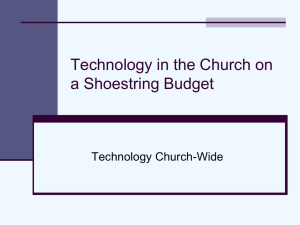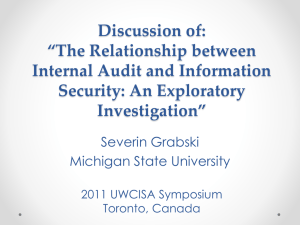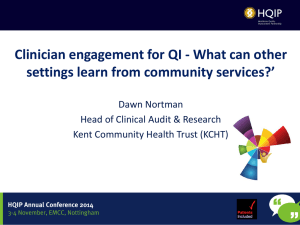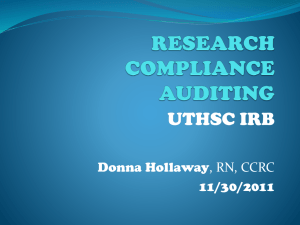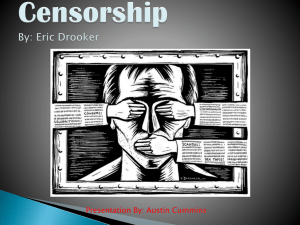Pressroom Maintenance Quality Audit
advertisement
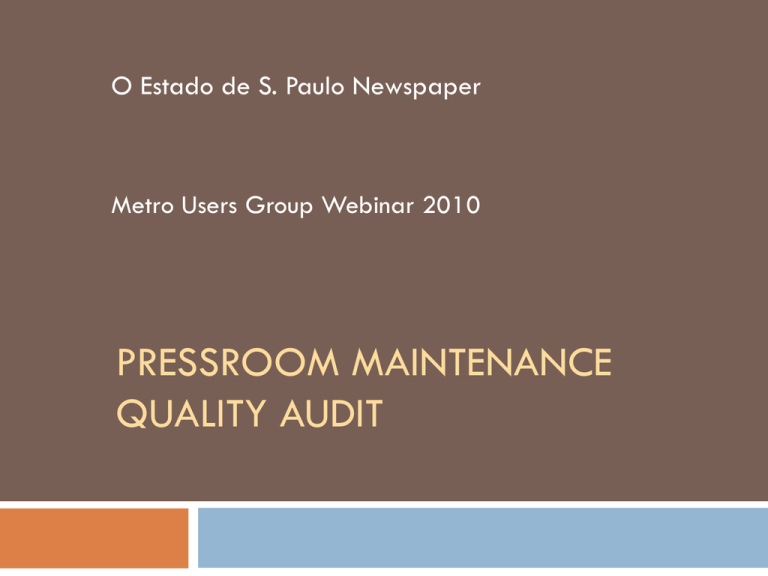
O Estado de S. Paulo Newspaper Metro Users Group Webinar 2010 PRESSROOM MAINTENANCE QUALITY AUDIT Speaker Roberto Dias Da Costa is the Industrial process supervisor at the Newspaper S.A. O Estado de S. Paulo, Brasil . He is a mechanical engineer with a specialization degree on maintenance management. He has been with S.A. O Estado for over 15 years. During this time he has worked as a mechanical maintenance supervisor and pressroom supervisor. On 2007 he coordinated, as a key user, the SAP ERP production planning module implementation on the industrial area. He was responsible for the Housekeeping (5S) implementation and coordination. He is also part of the waste recycling coordination group of the Newspaper. In his current position, he works in the Support and Analysis Department, being responsible for the industrial process definition and standardization, quality standard definition, work group coordination (waste reduction, operational training, parts, etc). He is also responsible for production data analysis and input in the SAP - PP module. Webinar Agenda “O Estado” Organization Industrial Department Quality Audit – Why and How Audity Group Actions Toward Quality Results Future Plan “ O Estado” Organization “O ESTADO” Organization “O ESTADO” Organization is one of the biggest and most respected Media group in Latin America, acknowledged by its seriousness, objectivity and by its engagement of over one century of credibility in rendered information. Number of employees 2.850 Paper consumption per year 50.000 tons Plate consumption per year 840.000 (broadsheet) Ink consumption per year 744 tons “O Estado” circulation 240.000 Monday – Saturday / 350.000 Sunday “Jornal da Tarde” circulation 70.000 (110.000 Wednesday) Total Subscribers 304.000 Net Revenue per year US$ 540 MM “O ESTADO” Organization “O Estado de S. Paulo” Newspaper “ESTADÃO”, as known today, was created in 1875 with the name of “A Província de São Paulo” and one ideal: “To establish a republican regime in Brazil, under democracy and without slaves”. After 135 years, “ESTADÃO” is today, one of the most important newspaper in Brazil, is among the 20 most important around the world and the main newspaper in São Paulo. Its revenue is composed by: Subscriptions = 20% Newsstand = 5% Advertisement = 75% Circulation : Monday to Saturday - 240.000 Sunday Edition – 350.000 “Jornal da Tarde” Newspaper Launched in 1966, as an evening paper. It covers the life in São Paulo, its inhabitants and services. Its revenue is composed by: Subscriptions = 16% Newsstand = 14% Advertisement= 70% Circulation : Daily Edition Average - 70.000 Wednesday edition – 110.000 Agência Estado Biggest News Agency in Brazil. Leadership in information quality. Real Time Information through Internet, Satellite and FM. “Eldorado” Radio “Nova Eldorado AM” Radio Station is one of the most important news source in São Paulo. “Eldorado FM” has a qualified audio program, playing Jazz, Blues, MPB and etc. Focus on AA public audience. “OESP Mídia” Company Since 1984, “OESP Mídia” is especialized in telephone directory and sectorial guides publications, focusing small to medium business. OESP Gráfica Commercial newspaper printing services. Internet Portal One of the biggest Brazil portal news, joining content from O Estado, JT, Radio Eldorado, classified and editorial. Industrial Department Industrial Department INDUSTRIAL DIRECTOR José Odair Bertoni PREPRESS MANAGER Jean Franco PRESSROOM/ MAILROOM MANAGER Eduardo de Sales PROCESS MANAGER Antonio Tadeu MAINTENANCE MANAGER Lúcio Lima Industrial Department Prepress Classified Pagination Advertising Reception and Preflight Plateroom Graphic Tech Support Film Making Room Industrial Department Pressroom 2 GOSS HEADLINER - 1991 Average production speed - 42.500 IPH 08 page color and 24 page black 2 GOSS NEWSLINER – 1997 Average production speed - 45.000 IPH 20 page color and 04 page black or 12 page color and 20 page black 2 COLORMAN - 2000 Average production speed - 50.000 IPH 48 page color or 40 page color and 16 page black Quality Audit- Why and How Quality Audit- Why and How The Brazilian newspaper market was facing a big challenge concerning to printing quality and readers demandings. Our newspaper has change its layout to accomplish those market changes and be more competitive with the other information technologies as the internet, palms and more. As a consequence, the printing quality, productivity and waste reduction became the most relevant issues in the Industrial area. Therefore we decided to hire Goss Quality Audit services to help us achieving these objectives. O Estado de S. Paulo and Goss teamed up to conduct the Quality Audit to improve print quality, productivity and reduce waste. Our efforts started with a lengthy team meeting to understand issues and identify objectives. The following is the summary: Quality Audit- Why and How 1. Optimum ink/water balance was needed and was regarded as priority one. The goal was that the operators didn’t adjust ink, at all, during make-ready. This required the following sub-categories: a. Modifying the control parameters; b. Investigating presets; c. Spray-bars evaluation; d. Dampening solution pumping system; e. Ink pumping system; f . The Newsliner’s ink train settings; g. The Newsliner’s dampening train settings; h. Consumable. 2. Registration optimization: a. Side-lay; b. Circumferential. 3. Waste savings reduction: a. Operational methodology. 4. The human factor: a. Press and Prepress. Audit Group Audit Group To accomplish the Quality Audit program we have created a multidisciplinary group, formed by professionals from Maintenance, Engineering, Pressroom and Prepress areas. From left to right: Marcal Santos Barbosa – Pressman Trainer; Valter Craveiro dos Santos – Prepress Support; Edson Silva Lima – Mechanical Maintenance Supervisor; Roberto Dias da Costa – Process Supervisor; Jamir Correa Pupo – Pressroom Supervisor; Rinaldo Francisco da Silva – Prepress Support; Vitor Nicolau Teixeira – Electrical Maintenance Supervisor; Edson Lino dos Santos – Engineering Supervisor. Group Methodology - Multi-disciplinary Group; - Goss coordination; - Six Sigma oriented. Actions Toward Quality Quality Group Spreadsheet We have created an spreadsheet with over 90 actions covered during and after the Quality Audit program. It was divided into Prepress, Pressroom, Engineering and Management categories . Actions Toward Quality Prepress (8 actions) Rip Interface PAR Test Form Color Management Pressroom (72 actions) Dampening System Inking System Meridian Operation Engineering (8 actions) Dampening Curve Inking Curve Blanket Fountain Solution Management (5 actions) OPB RIP Six Sigma Pressman Training Mechanical Audit Actions Toward Quality Prepress – Some actions examples: Rip Interface Possibility of linking the RIP to the Newsliner. PAR Adjusted the Meridian presets; Overall maintenance; Corrected film pattern. Test Form Created a new test form to check ink and registration. Goss TestForm Based on the Quality program we have created this new testform to set up our Newsliner Presses. It has Solid bars with 75 and 40% of coverage in each color and also registration marks. Actions Toward Quality Pressroom – Some actions examples: Spray bar Nozzle Tip, Plunger, chamber and Valve body Model standardization: We have found some nozzle tips with the wrong model in stock as well some plungers with different rubber material and body valves with different o’ring channel dimensions. Chemical compatibility test; Maintenance procedures; Receiving inspection and analisys; Tester development . Flow Metering Device This tester device was created to analise the nozzle tip flow and the plunger performance prior to enter in our stock and during regular maintenance. It performes a predetermined flow test. Based on the volume variance (± 3%) the nozzle tip and plunger is accepted or rejected. Digital Microscopy Dampening uniformity is critical to waste savings. We created a procedure to evaluate the nozzle tips, chambers and plungers through digital microscopy before it enters our stock and during regular maintenance. With this test we can evaluate the nozzle tip diameter and encrustation, chamber scratches that can alter the magnetic field and plunger rubber surface condition that can alter the “On Time” value. Ultrasound Cleaning Device Equipment used to clean the spraybar nozzle tip. Actions Toward Quality Pressroom – Some actions examples: Dampening System Spray bar Tester device; Change of the dampening solution unit regulator; Modify Spray bar to reflect the actual web width (54” to 50”); Adjust the water form roller to not slip. Spray Bar Tester Based on the Quality program information we have built this spraybar tester in order to balance and equalize the nozzle spray. Dampening Fluid Regulator As a recommendation from the Goss audit program, we have changed the Dampening fluid regulator. The new regulator in use is from Technotrans. With the previous regulator we could not get a uniform dampening pressure. The pressure variation range was ± 20 psi during the press running. With the new model the pressure variation range is ± 5 psi, resulting in a more uniform dampening flow during the run. Actions Toward Quality Pressroom – Some actions examples: Inking System Dry Solid Ink test on units; Overall maintenance on digital page pack and fountain roller; Equalization of Ink pressure line (30 to 40 psi). Actions Toward Quality Pressroom – Some actions examples: Ink and Water curves optimization; Ink and dampening uniformity. Actions Toward Quality Pressroom – Some actions examples: Register pin Optimization: We are still working on the register pin optimization. We have done some measurements with the test form and created some statistical graphs, showing the deviation to be corrected. Actions Toward Quality Engineering – Some actions examples: Discussed the science and technology of emulsion behavior, and the interaction between ink, dampening solution, plate design and the press roller train; Plate room temperature and humidity control; Press Parameters review: Cold Autoflood Duration; Warm Autoflood Duration; Warm Start Autoflood Duration; Ink Form On Delay. Actions Toward Quality Management – Some actions examples: Mr. Ragy Isaac provided two and half hours Six Sigma overview; Study of a CTP viability for the Prepress area. Results Results After this period the Audit Group was able to achieve the following objectives: Results - Reduced start-up waste: Newsliner 2008 Average – 860 copies Newsliner 2009 Average – 690 copies Results - Web breaks reduction: 2008 Web Break Rate - 4,17% 2009 Web Break Rate – 3,51% 2008/2009 comparison: On start-up – 64% During the run – 32% During the paste cycle – 21% On press stop – 53% Results - Established new Ink Curves: Results - Established new Dampening Curves: Results - Produced drier printed product with a stable ink and water balance; - Trained all press crews on the use of Percent Mode to set density if required; - Provided details of the spray-bars technology’s pitfalls and how to avoid it. The discussion included the theory of operations of a spray-bar, controls required; - Identified the proper dampening solution pressure at the Newsliner’s unit regulator (60 psi); - Identified, and corrected, the PAR as the major cause for inking unpredictability.; - Improved the overall print quality. Future Plans Future Plan - Lean Six Sigma implementation; - CTP and OPB for Goss Press; - Goss Pressman training; - Goss Mechanical Audit; - Newsliner/Headliner controls upgrade. O Estado de S. Paulo Newspaper THANK YOU! roberto.costa@grupoestado.com.br
